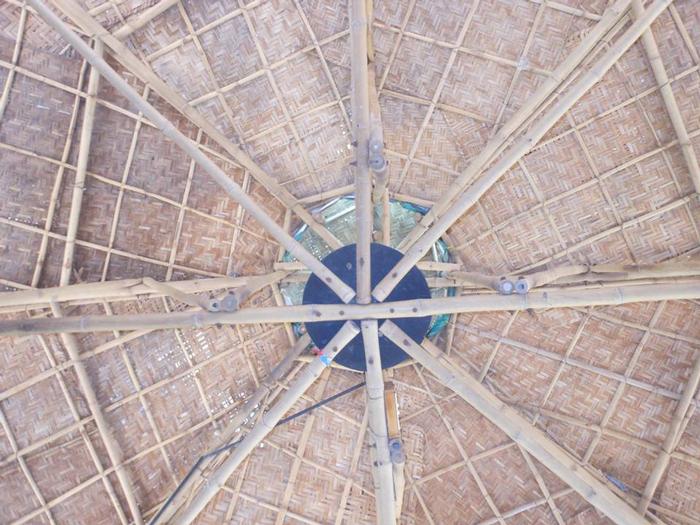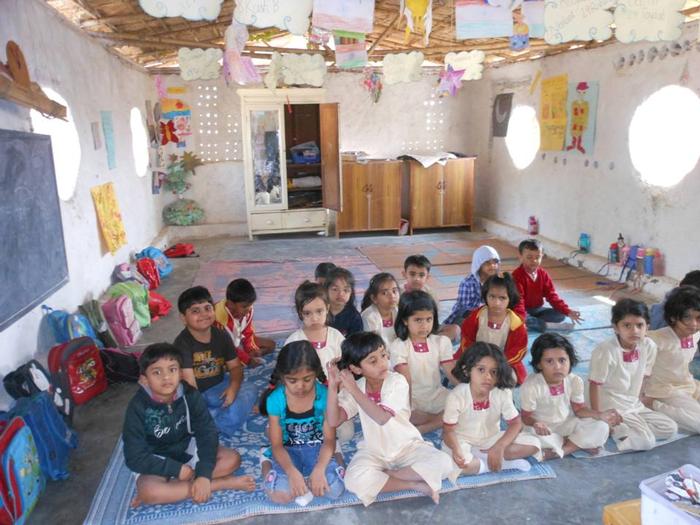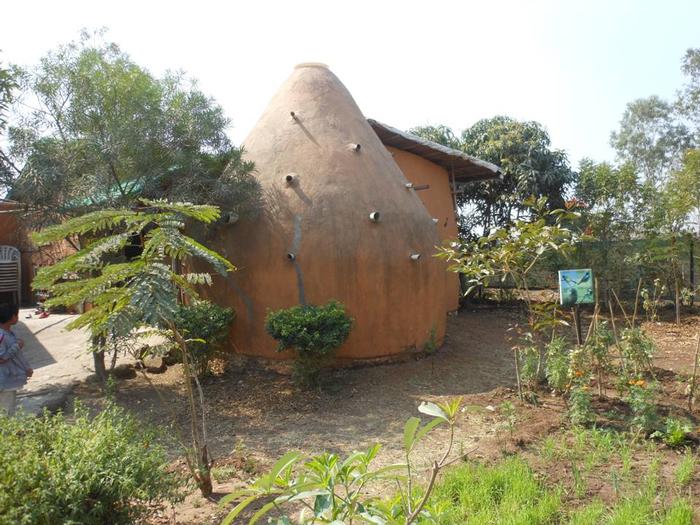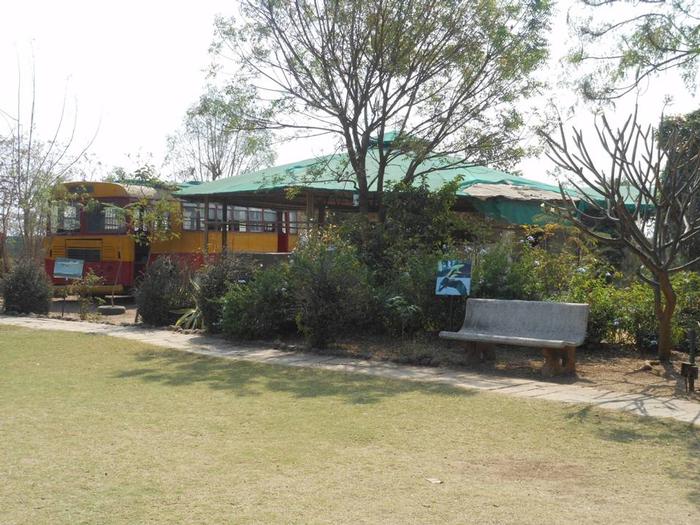[ID:355] The Bridge to EducationIndia “Architecture of all the arts is the one which acts the most slowly, but, the most surely, on the soul.”-Ernest Dimnet.
I’m sitting in a corner of the classroom that the kids call ‘ROCKET ROOM’ watching God’s eldest daughter, Light, perform tricks on the wall. The PVC pipes embedded in the wall by the architect, Sourabh Phadke, enable her to do so. It’s then that I remember what Leo Tolstoy said in his novel, Family Happiness, “One of the first conditions of happiness is that the link between man and nature shall not be broken.” I find myself resting my ear against the pipe and listening to the sound of the breeze gushing through it. I look up in gratitude towards the lord, and the sunlight from the skylight, bathes me in all its glory. The cool flooring, in local stone, the self textured mud walls and the bamboo mats all just seemed to add to the appeal of the room.
I was reminded of the ancient Indian “Gurukul “system, where all the students were equal, in spite of their social standings, they had no fancy infrastructure and they sat on the floor along with the teacher. The structure was just a mere catalyst to serve the purpose of education.
‘AMAN SETU’ which means a bridge to peace, is what the school is called. The mud walls, corbelled windows, thatched roofs all seemed to blend in with the surrounding. As I walked through the grass, a six year old, walked up to me and asked me if I liked her school. She was thrilled with my reply and then told me that her friends and her drew a picture for their Ecology teacher , who was also the architect and he constructed exactly what they drew. It was then that I realized that to translate emotions into a building,one did not need a degree, just a little bit of sensitivity and a big heart!
She wanted me to walk with her around her school. Here I was, on a picnic with a six year old!
I watched her take little steps through the lawn outside the rocket room and make her way to “Chintu- the bus.” She noticed the question mark on my face and before I could form my first word, there she was, talking about the bus. “Chintu”, which in Hindi means tiny, was their science and Mathematics laboratory. It was from her that I learnt that this bus shell was brought from a scrap dealer, recycled and refurbished to create this shelter. The use of a Bus shell to create a teaching space is a novel idea but to have a bus for a classroom is a matter of pride for every child studying here!
For a minute, I was astounded with the simplicity and the clarity with which she explained the existence of the bus. To realise the importance of recycling, or how to put waste to use, at such a young age, is not what a book can do, it’s something that a building can do. Buildings command a way of life and children learn what the live!
Buildings over their entire lifetime silently impact their users on an everyday basis. The effect is certain, yet unnoticed. Why is it that a tunnel feels scary or a temple, peaceful? Each building commands its own way of life. As architects, planners and builders, the significance of what we create is enormous because we not only build structures, we help generate auras. I have mentioned the word “aura” because that is what draws us towards a structure or makes us detest it. The significance of good buildings is that they play a major role in building and strengthening the community, the city and its people.
In a city like Pune, with proposals to create 100 municipal corporation schools in the next three years, this school would an excellent prototype. It would involve everybody in the community- municipal corporators, architects, students, children and the masons. The effect that the school building has on the children is marvellous. The semi open classroom is a true example of this. Christened Kaleidoscope, this circular structure, has a very interesting roof made of bamboo and thatch mats. Watching the kids run to and fro from this area to the small pond nearby or to the adjacent bus was like reliving my childhood. On further enquiry, I learnt, that a group of architecture students, volunteered to weave these mats as a project submission for their materials class. The coming together of architecture students to help construct a low cost school, reminded me of what Sir Frank Lloyd Wright once said “Maybe we can show the Government how to operate better as a result of better Architecture.”
While I stood facing kaleidoscope, some tykes from their classroom kept staring at me from the circular punctures in the wall. Ten steps from there and I was staring at kaleidoscope from the circular punctures. The quality of light that the punctures brought into the room was brilliant. The best part about this classroom, called Champa (which is the Indian name for the frangipani flower), was that that there actually was a Champa tree in the semi covered verandah outside. The recycling motto of the school was to be seen here as well. Lower halves of coke bottles had been embedded in the flooring around the tree. Kids alternately rubbed their feet against the smooth floor and the bottle halves. The difference in the texture excited them and compelled them to do the same activity over and over again.
Public significance is a very heavy word. A building may have been built for public good, but the day to day working, the systems it follows and the maintenance of that building play a very big role in making it actually significant and alive. The transport systems and public toilets in India are all made for the public good; however, they fail when it comes to actual day to day functioning. What we end up having is a failed transport system and people defecating on the streets. Amongst all of this, the school seems like a ray of hope. It reinstates that social good is not a myth, but an achievable reality. The school makes it mandatory for all the kids to use the same transport system. Thus saving on the fuel costs and encouraging interaction. The wonderful part here is that the children are aware of how travelling together helps save mother Earth.
As I pondered and mingled around, I happened to notice a very colourful screen. A screen made of plastic bottles stacked into each other. The green bottles and the sunlight, created a beautiful myriad of colours on the opposite side. An oxymoronic thought gripped me, ‘beautiful waste’!
To be able to have a design that suits all, especially in a country like India, where the gap between the rich and poor just keeps increasing and where one still at times faces the aftermaths of the caste system, is remarkable.
Providing education and being an educationist is a very responsible job. However, of recent times, it has become a money making gimmick. Schools are not judged by the environment or the learning methodologies but by the number of air conditioners in each classroom. The innocence of childhood has somehow disappeared with time. Each structure in this campus has come up, as and when the requirement for another space came up, yet it all blends in so well. I was lucky enough to meet the architect at the school. I learnt from him that the school uses UDDT toilets- urine diversion dehydration toilets. They separate the urine from the solid human waste. The same are used respectively in gardening- for creating manure. The school in every way supports a sustainable lifestyle.
Children at this school are aware of the waste management problems Pune faces. Thus they try to account for the waste the school creates .A step that every Pune citizen must take. This everyday process of dealing with waste is something that the structure supports inherently.
A green building or a green roof cannot be isolated and spoken about in fancy terms. Technically, it is a green lifestyle that we should speak about. Public good though for the public, depends on the public. A very learned man once said, “If something is good or ugly, it’s because people want it that way.” Every common man is not an architect, but every architect is a common man. The onus lies on us architects to educate our society about these intricacies of livelihood. Sustainability for the common man is related to money, but for us it starts a whole new dialogue. This dialogue is what we should have with our fellow people, through our buildings.
Gujarat, a state in India, has started constructing schools, on similar lines of AMAN SETU, in the entire state. India has a very high percentage of young population. If the entire percentage is educated, the country will once again be able to live its golden era. This school is what I would call the one small step in the history of mankind. We have many more such steps to go. The good that comes out of a well designed building is infectious. It touches every person who comes in contact with the structure.
The design principles used in this school could also be used to create prototype houses for the poor. Slums which are growing like amoeba could be curbed and we could create well planned communities. Asia’s biggest slum, Dharavi, is situated in Mumbai. Imagine the kind of employment such kind of a project could create. Respectable shelters would be the biggest reward of such an undertaking. Rammed earth construction does not require highly skilled labour. Delivering a good product at the end would also be comparatively easy.
A building lives longer than the architect does, hence it affects more amounts of people that the architect can. To create spaces that one feels like coming back to is a bigger laurel an architect can ever achieve. To find the right balance in the intangible aspects of the structure, to even consider them, is the mark of a good architect. The consequences come a result of existence, what matters more, is the thought that is put in before the actual existence.
The though put in by the architect at Aman Setu has helped established a holistic, meditative and pure environment for the children. When a building fits perfectly within its surrounding, it automatically becomes a part of its cultural ethos.
When one starts seeing good architecture, one starts associating a sacred value to it. This value starts re emphasizing the importance of that structure in the society. For every brick we put together on site, we must know that we are impacting hundreds of souls. Children at Aman Setu, will turn out to be responsible and aware individuals , and the credit goes to the architect. The benefactors here are not only the kids, but also their parents and the nation. It’s all a very big cycle- the cycle of Life.
Involvement plays a huge role in creating significant and successful buildings. The involvement of the children at the design stage, the involvement of the local people during the construction and the involvement of the students throughout is the reason behind the success story of Aman Setu. The love energy of all these people at different stages of work has manifested itself in the form of what we call Aman Setu.
Pune needs at least seventy five schools like Aman Setu, only then, will it be possible to live Jawaharlal Nehru’s dream of an educated India. With a country like India which is still in its developing stage, schools which take care of the cost and yet serve their purpose become a need of the hour. These schools become a part of the fabric that binds the city and I hope one day become an identity for the city. World over schools like these can be replicated and children can be educated. When the needs are few, it is very easy to survive. With few material needs, a school like this will not only survive but thrive.
One of the most important outcomes of interesting schools like Aman Setu is that the children here are perpetually in love with it thus encouraging them to go to school every day. If every school got this interesting, there would be a decline in the number of beggars and child labourers.
Architecture is like frozen music. It stands there timeless. We need to create harmony in our music. We need to strike a right balance in the chords. Only then will our buildings sing. We must create a system by which our buildings survive and that is what this school has achieved. There stands today in the city of Pune, a perfect epitome of the union of Man and Nature.
If you would like to contact this author, please send a request to info@berkeleyprize.org. |




